2007 CHEVROLET SILVERADO tire size
[x] Cancel search: tire sizePage 578 of 684
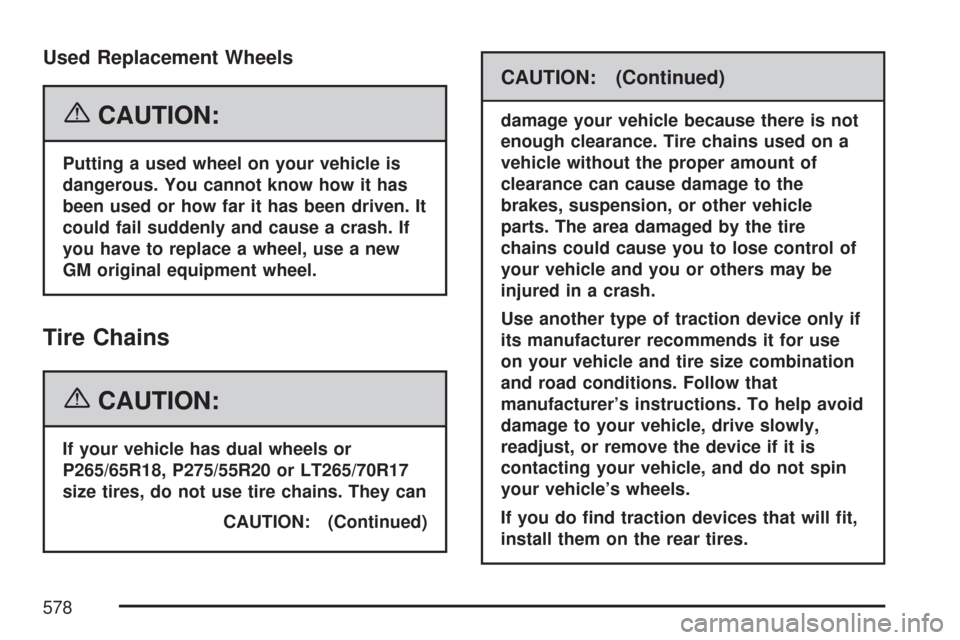
Used Replacement Wheels
{CAUTION:
Putting a used wheel on your vehicle is
dangerous. You cannot know how it has
been used or how far it has been driven. It
could fail suddenly and cause a crash. If
you have to replace a wheel, use a new
GM original equipment wheel.
Tire Chains
{CAUTION:
If your vehicle has dual wheels or
P265/65R18, P275/55R20 or LT265/70R17
size tires, do not use tire chains. They can
CAUTION: (Continued)
CAUTION: (Continued)
damage your vehicle because there is not
enough clearance. Tire chains used on a
vehicle without the proper amount of
clearance can cause damage to the
brakes, suspension, or other vehicle
parts. The area damaged by the tire
chains could cause you to lose control of
your vehicle and you or others may be
injured in a crash.
Use another type of traction device only if
its manufacturer recommends it for use
on your vehicle and tire size combination
and road conditions. Follow that
manufacturer’s instructions. To help avoid
damage to your vehicle, drive slowly,
readjust, or remove the device if it is
contacting your vehicle, and do not spin
your vehicle’s wheels.
If you do �nd traction devices that will �t,
install them on the rear tires.
578
Page 579 of 684
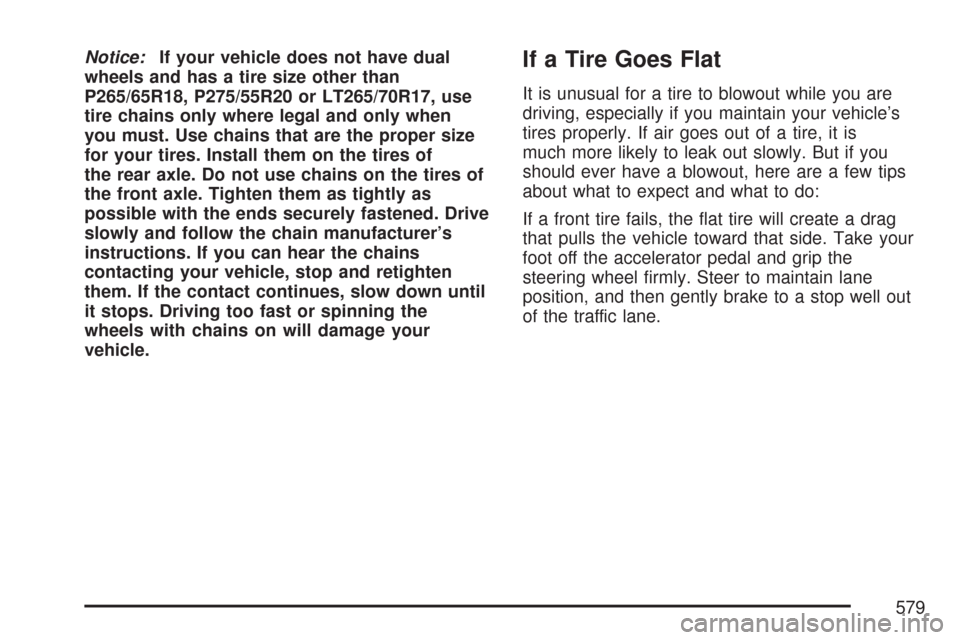
Notice:If your vehicle does not have dual
wheels and has a tire size other than
P265/65R18, P275/55R20 or LT265/70R17, use
tire chains only where legal and only when
you must. Use chains that are the proper size
for your tires. Install them on the tires of
the rear axle. Do not use chains on the tires of
the front axle. Tighten them as tightly as
possible with the ends securely fastened. Drive
slowly and follow the chain manufacturer’s
instructions. If you can hear the chains
contacting your vehicle, stop and retighten
them. If the contact continues, slow down until
it stops. Driving too fast or spinning the
wheels with chains on will damage your
vehicle.If a Tire Goes Flat
It is unusual for a tire to blowout while you are
driving, especially if you maintain your vehicle’s
tires properly. If air goes out of a tire, it is
much more likely to leak out slowly. But if you
should ever have a blowout, here are a few tips
about what to expect and what to do:
If a front tire fails, the �at tire will create a drag
that pulls the vehicle toward that side. Take your
foot off the accelerator pedal and grip the
steering wheel �rmly. Steer to maintain lane
position, and then gently brake to a stop well out
of the traffic lane.
579
Page 600 of 684
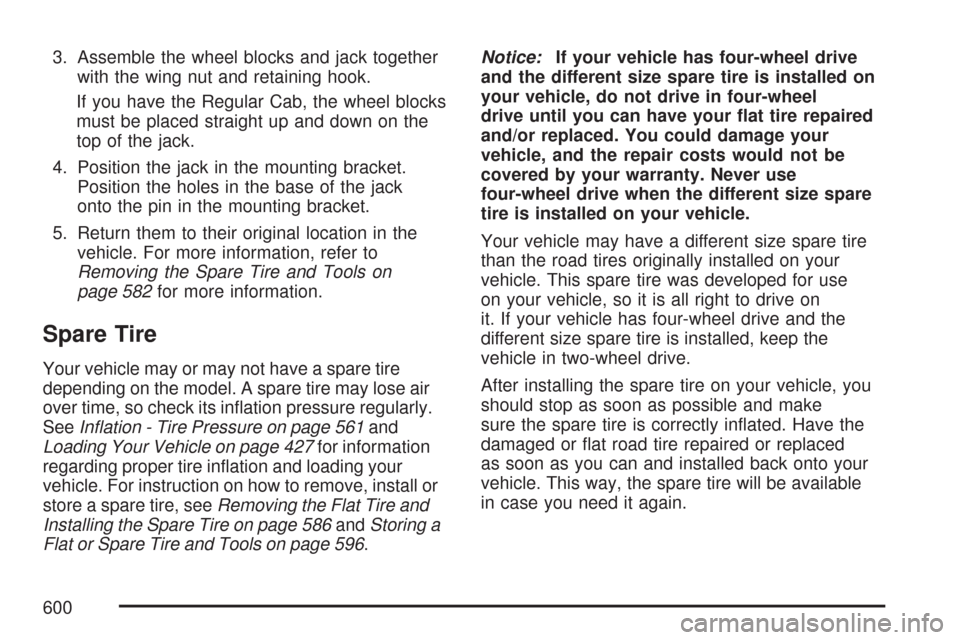
3. Assemble the wheel blocks and jack together
with the wing nut and retaining hook.
If you have the Regular Cab, the wheel blocks
must be placed straight up and down on the
top of the jack.
4. Position the jack in the mounting bracket.
Position the holes in the base of the jack
onto the pin in the mounting bracket.
5. Return them to their original location in the
vehicle. For more information, refer to
Removing the Spare Tire and Tools on
page 582for more information.
Spare Tire
Your vehicle may or may not have a spare tire
depending on the model. A spare tire may lose air
over time, so check its in�ation pressure regularly.
SeeIn�ation - Tire Pressure on page 561and
Loading Your Vehicle on page 427for information
regarding proper tire in�ation and loading your
vehicle. For instruction on how to remove, install or
store a spare tire, seeRemoving the Flat Tire and
Installing the Spare Tire on page 586andStoring a
Flat or Spare Tire and Tools on page 596.Notice:If your vehicle has four-wheel drive
and the different size spare tire is installed on
your vehicle, do not drive in four-wheel
drive until you can have your �at tire repaired
and/or replaced. You could damage your
vehicle, and the repair costs would not be
covered by your warranty. Never use
four-wheel drive when the different size spare
tire is installed on your vehicle.
Your vehicle may have a different size spare tire
than the road tires originally installed on your
vehicle. This spare tire was developed for use
on your vehicle, so it is all right to drive on
it. If your vehicle has four-wheel drive and the
different size spare tire is installed, keep the
vehicle in two-wheel drive.
After installing the spare tire on your vehicle, you
should stop as soon as possible and make
sure the spare tire is correctly in�ated. Have the
damaged or �at road tire repaired or replaced
as soon as you can and installed back onto your
vehicle. This way, the spare tire will be available
in case you need it again.
600
Page 601 of 684
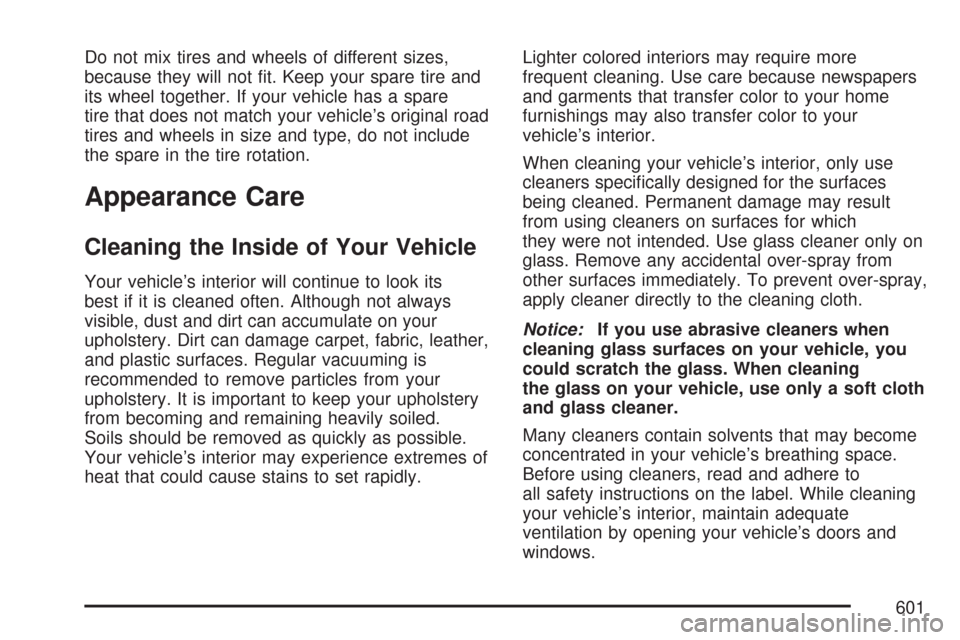
Do not mix tires and wheels of different sizes,
because they will not �t. Keep your spare tire and
its wheel together. If your vehicle has a spare
tire that does not match your vehicle’s original road
tires and wheels in size and type, do not include
the spare in the tire rotation.
Appearance Care
Cleaning the Inside of Your Vehicle
Your vehicle’s interior will continue to look its
best if it is cleaned often. Although not always
visible, dust and dirt can accumulate on your
upholstery. Dirt can damage carpet, fabric, leather,
and plastic surfaces. Regular vacuuming is
recommended to remove particles from your
upholstery. It is important to keep your upholstery
from becoming and remaining heavily soiled.
Soils should be removed as quickly as possible.
Your vehicle’s interior may experience extremes of
heat that could cause stains to set rapidly.Lighter colored interiors may require more
frequent cleaning. Use care because newspapers
and garments that transfer color to your home
furnishings may also transfer color to your
vehicle’s interior.
When cleaning your vehicle’s interior, only use
cleaners speci�cally designed for the surfaces
being cleaned. Permanent damage may result
from using cleaners on surfaces for which
they were not intended. Use glass cleaner only on
glass. Remove any accidental over-spray from
other surfaces immediately. To prevent over-spray,
apply cleaner directly to the cleaning cloth.
Notice:If you use abrasive cleaners when
cleaning glass surfaces on your vehicle, you
could scratch the glass. When cleaning
the glass on your vehicle, use only a soft cloth
and glass cleaner.
Many cleaners contain solvents that may become
concentrated in your vehicle’s breathing space.
Before using cleaners, read and adhere to
all safety instructions on the label. While cleaning
your vehicle’s interior, maintain adequate
ventilation by opening your vehicle’s doors and
windows.
601
Page 682 of 684

Storage Areas (cont.)
Cupholder(s)............................................ 198
Glove Box................................................ 198
Instrument Panel Storage Area................. 199
Luggage Carrier....................................... 200
Rear Seat Armrest................................... 201
Stuck in Sand, Mud, Ice, or Snow............... 424
Sun Visors.................................................. 129
Sunroof....................................................... 202
System Identi�cation, Universal Home
Remote System....................................... 186
T
Tachometer................................................. 250
Tailgate....................................................... 124
Taillamps
Turn Signal, Stoplamps and Back-up
Lamps.................................................. 548
Theft-Deterrent, Radio................................. 370
Theft-Deterrent Systems.............................. 129
Content Theft-Deterrent............................ 130
PASS-Key
®III+........................................ 131
PASS-Key®III+ Operation........................ 132Tilt Wheel.................................................... 214
Time, Setting............................................... 303
Tire
Pressure Light.......................................... 261
Tires........................................................... 552
Aluminum or Chrome-Plated Wheels,
Cleaning............................................... 607
Buying New Tires..................................... 572
Chains..................................................... 578
Changing a Flat Tire................................ 580
Cleaning.................................................. 608
Different Size........................................... 574
Dual Tire Operation.................................. 562
If a Tire Goes Flat................................... 579
In�ation - Tire Pressure............................ 561
Inspection and Rotation............................ 568
Installing the Spare Tire........................... 586
Pressure Monitor System ......................... 563
Removing the Flat Tire............................. 586
Removing the Spare Tire and Tools......... 582
Secondary Latch System ......................... 592
Spare Tire................................................ 600
Storing a Flat or Spare Tire and Tools..... 596
Tire Sidewall Labeling.............................. 553
682
Page 684 of 684
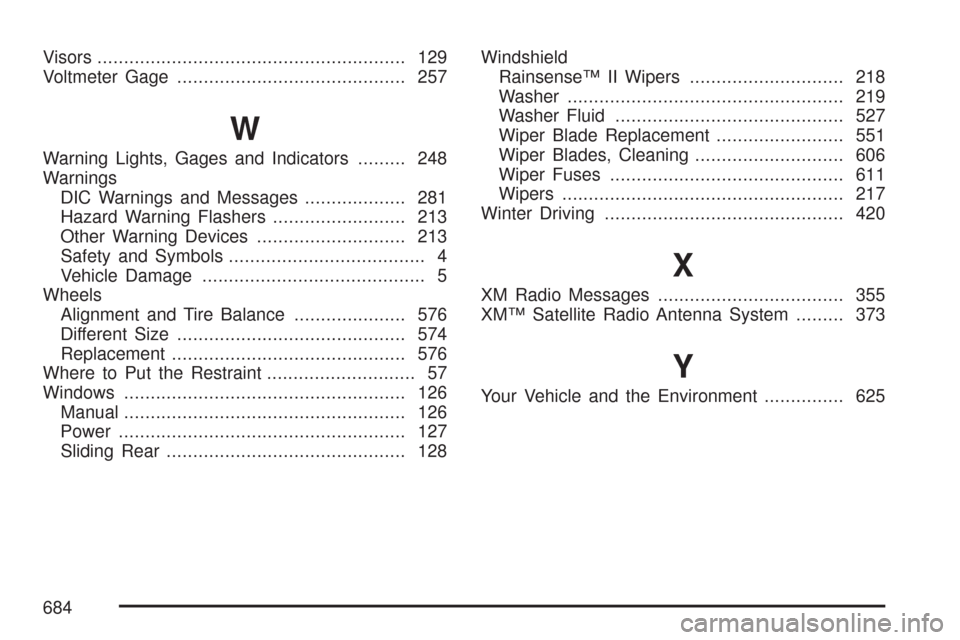
Visors.......................................................... 129
Voltmeter Gage........................................... 257
W
Warning Lights, Gages and Indicators......... 248
Warnings
DIC Warnings and Messages................... 281
Hazard Warning Flashers......................... 213
Other Warning Devices............................ 213
Safety and Symbols..................................... 4
Vehicle Damage.......................................... 5
Wheels
Alignment and Tire Balance..................... 576
Different Size........................................... 574
Replacement............................................ 576
Where to Put the Restraint............................ 57
Windows..................................................... 126
Manual..................................................... 126
Power...................................................... 127
Sliding Rear............................................. 128Windshield
Rainsense™ II Wipers............................. 218
Washer.................................................... 219
Washer Fluid........................................... 527
Wiper Blade Replacement........................ 551
Wiper Blades, Cleaning............................ 606
Wiper Fuses............................................ 611
Wipers..................................................... 217
Winter Driving............................................. 420
X
XM Radio Messages................................... 355
XM™ Satellite Radio Antenna System......... 373
Y
Your Vehicle and the Environment............... 625
684